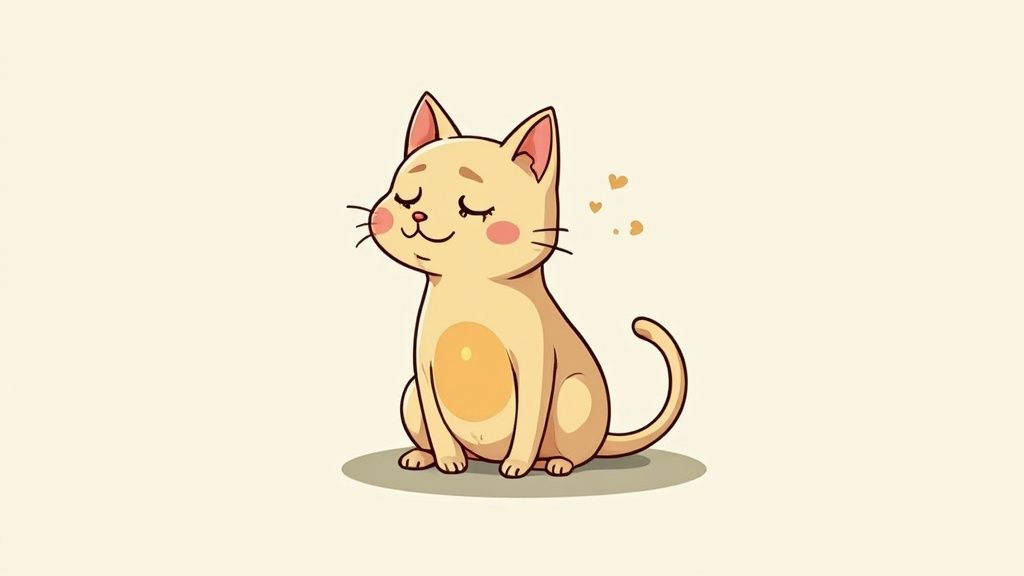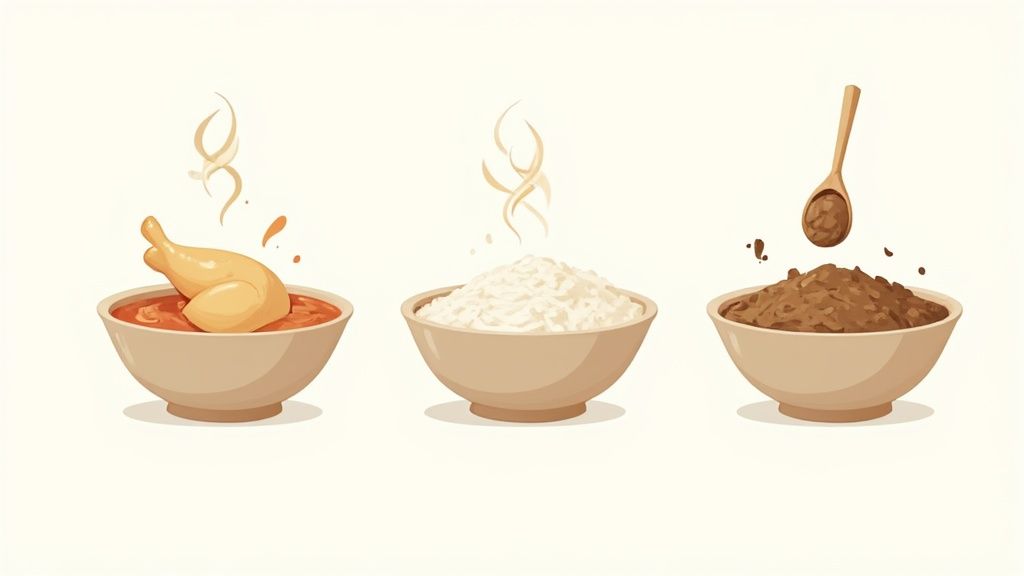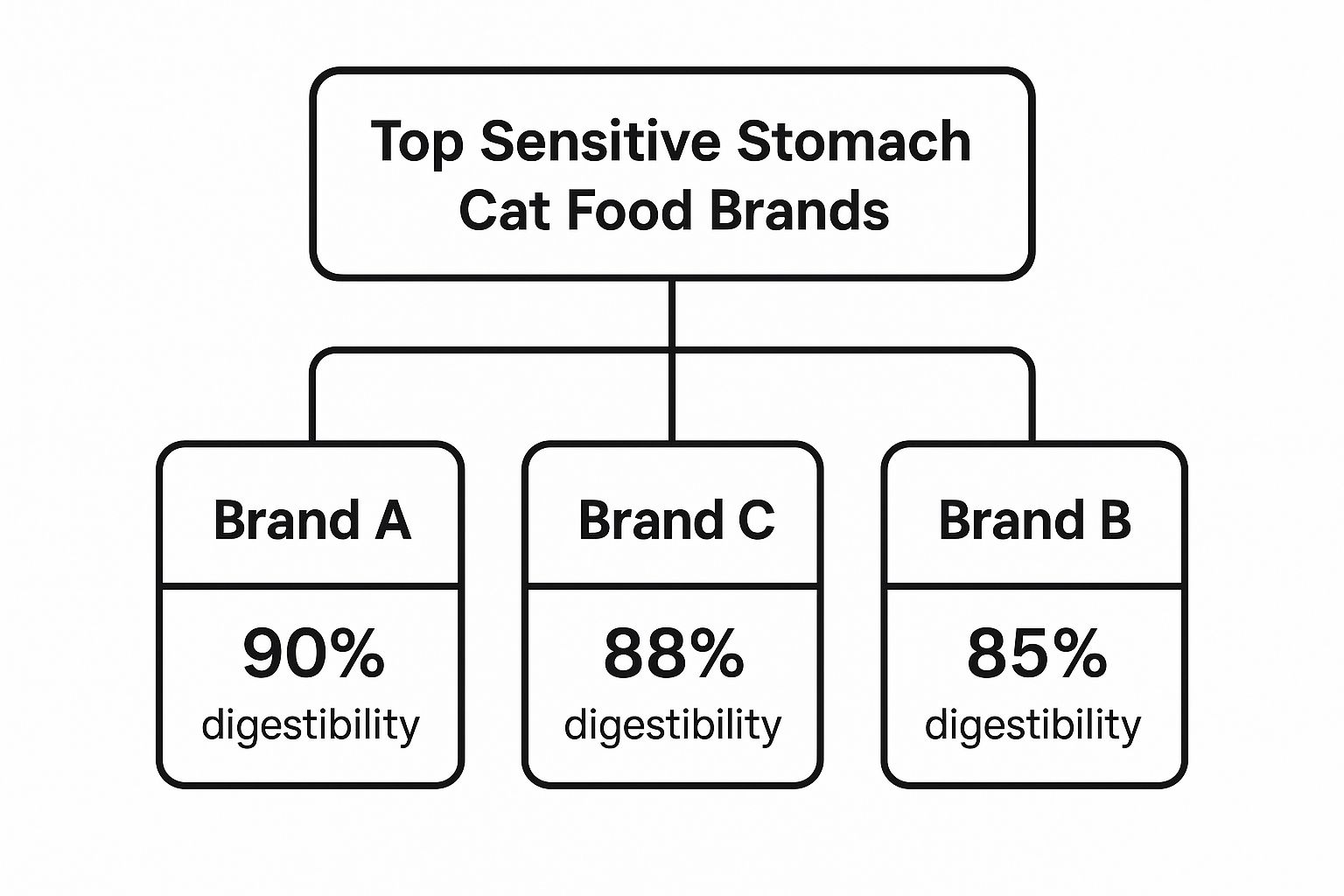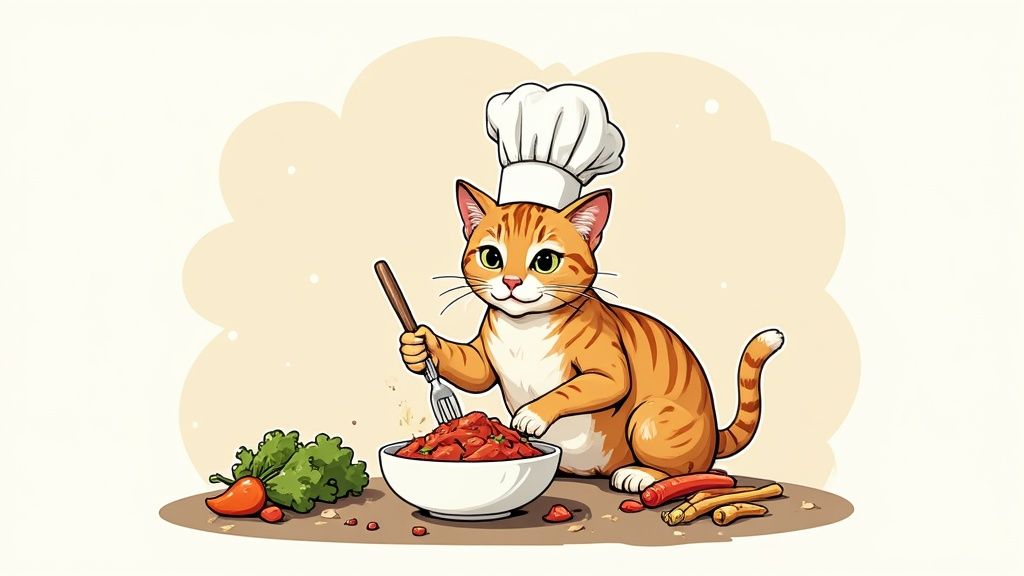Finding the Best Sensitive Stomach Cat Food
Published on August 15, 2025
When you hear "sensitive stomach cat food," what does that actually mean? It's a diet crafted specifically to be gentle on your cat's digestive system. Think highly digestible ingredients, a shorter list of potential allergens, and often a boost of gut-friendly probiotics to calm things down.
For a cat with a delicate tummy, this kind of food is often the first and most important step toward feeling better, helping to cut down on issues like vomiting, diarrhea, and gas.
Decoding Your Cat's Digestive Distress

It’s completely normal to worry when your cat isn't quite themselves. Sometimes the signs are subtle—a little bit of throw-up here and there, loose stool, or more gas than usual. While it's easy to jump to the worst conclusion, these symptoms don't always signal a major illness. Often, they're just your cat's way of telling you that their current food isn't sitting right.
I like to think of a cat's digestive system as a finely-tuned ecosystem. When everything is in harmony, it works beautifully. But introduce one wrong ingredient—like a weed in a flowerbed—and that delicate balance gets thrown off, leading to discomfort.
Recognizing the Signs of a Sensitive Stomach
Figuring out what's wrong is the first step to making it right. A sensitive stomach can show up in a few different ways, and sometimes the signs are so subtle you might miss them at first. The key is to watch for patterns.
Here are the most common clues that point to a sensitive stomach:
- Occasional Vomiting: We're not talking about the occasional hairball. If your cat is frequently vomiting up their food, that's a red flag.
- Changes in Stool: Diarrhea or constipation is often a direct sign that their food isn't being digested properly.
- Excessive Gas: A noticeable increase in flatulence is a classic symptom of digestive upset.
- Lack of Appetite: If your cat starts avoiding their food bowl, they might be associating their meals with feeling unwell.
If you're nodding along to this list, it’s probably time to look into a sensitive stomach cat food designed for easier digestion.
A cat’s digestive tract is remarkably efficient but also incredibly sensitive. A diet that is difficult to digest forces the system to work overtime, often leading to inflammation and discomfort. The goal of a specialized diet is to reduce this workload and restore balance.
Switching to the right food is one of the most powerful things you can do for your cat. These special formulas are made to be gentle but still pack in all the essential vitamins and minerals your cat needs, just without the ingredients that tend to cause trouble.
It’s amazing how often a simple change in diet can resolve these issues, getting your cat back to their happy, purring self. Finding the right solution is absolutely within reach.
Why Some Cats Have Sensitive Stomachs

Figuring out why your cat has an upset stomach can feel like a real mystery. The answer isn't always obvious and can be anything from their daily routine to a problem with their food. More often than not, the trouble starts with a sudden switch in their diet.
Think about it this way: if you ate the same thing every day and then suddenly swapped to a completely different cuisine, your stomach would probably complain. A cat’s digestive system is even more sensitive to change. A quick food swap can throw their gut into chaos, leading to vomiting or diarrhea. That's why vets always stress the importance of a slow, gradual transition to any new food.
Food Allergies vs. Intolerances
Sometimes, the problem isn't the change itself, but a specific ingredient in their food. This is where it’s crucial to know the difference between a food allergy and a food intolerance—they sound similar but are very different issues.
A food allergy is an immune system problem. Your cat's body incorrectly flags a common protein, like chicken or beef, as a dangerous threat and attacks it. This can lead to digestive issues, but you'll often see skin problems too, like constant itching or inflamed patches.
A food intolerance, on the other hand, is purely a digestive issue. It means your cat's gut just can't properly break down a certain ingredient, like lactose from dairy or a particular type of grain. The result is tummy trouble—gas, bloating, and diarrhea—without the immune-related skin reactions.
An intolerance is like a person who gets a stomachache after drinking milk. An allergy is a much bigger, body-wide reaction. In both cases, the solution involves finding and eliminating the culprit ingredient, which is exactly what a sensitive stomach cat food is designed to help with.
This isn't just a niche concern anymore. The global market for sensitive stomach cat food is projected to grow significantly by 2025 as more owners recognize these dietary issues in their pets. You can find more details on this growing trend in this market research report.
The Hidden Role of Stress
Diet isn’t the only thing to consider. Never underestimate what stress can do to a cat’s stomach. Cats thrive on routine and can get very anxious about changes in their world. Bringing home a new pet, moving, or even just shifting the furniture around can be enough to cause them real anxiety.
That mental stress can easily show up as physical digestive upset. The brain-gut connection is powerful in cats, and feelings of anxiety can disrupt their digestion, causing symptoms that look just like a food sensitivity.
Think of your cat's digestive system like a calm pond. A bad ingredient is a rock tossed in, creating ripples of discomfort. Stress, however, is like a constant, agitating wind that keeps the water choppy.
By keeping these triggers in mind—sudden dietary changes, problematic ingredients, and even stress—you'll be much better equipped to work with your vet. Finding the root cause is always the first step toward getting your cat’s digestive health back on track.
How to Choose the Right Sensitive Stomach Cat Food
Walking into the pet food aisle can be a head-spinning experience, especially when you’re on a mission to calm your cat’s upset tummy. With rows of bags and cans all claiming to be the best, how do you actually find the right one? The key is to learn how to read the label like a pro, focusing on what's inside and, just as important, what's been left out.
Your mission is to find a food that makes digestion as easy as possible. That usually means looking for recipes built around a single, high-quality animal protein and other gut-friendly ingredients.
Master the Ingredient Label
When you turn over a bag of cat food, pay close attention to the first five ingredients—they make up the majority of what your cat will be eating. For a kitty with a sensitive system, this is where you need to put on your detective hat.
What to look for:
- A Named Meat as the First Ingredient: Simple, clear terms like "Chicken," "Turkey," or "Duck" are what you want to see. Vague phrases like "meat by-products" or "poultry meal" are red flags because you can't be sure of the source.
- Novel Proteins: If you think a food intolerance is the culprit, a novel protein can be a real game-changer. This is simply a protein your cat probably hasn't eaten before, like rabbit or venison, making it far less likely to cause a reaction.
- Digestible Carbohydrates: Gentle carbs such as sweet potatoes or peas are great for providing energy without overloading the digestive system. They're often much easier for cats to process than common fillers like corn or wheat.
This shift toward carefully selected ingredients is a growing trend. In fact, the global cat food market is expected to jump from USD 66.6 billion in 2025 to a whopping USD 91.2 billion by 2035. This growth is fueled by owners like you demanding specialized diets for their pets. You can find more insights on the evolving cat food market and its trends.
Comparing Sensitive Stomach Cat Food Formulas
Not all sensitive stomach formulas are built the same. They typically fall into a few categories, each tackling digestive issues from a different angle. Figuring out which one fits your cat's specific problem is the next step.
Here's a quick breakdown to help you compare the most common types of sensitive stomach foods.
| Formula Type | Key Features | Best For Cats With |
|---|---|---|
| Limited Ingredient Diet (LID) | Contains a single animal protein and minimal carbs to reduce potential triggers. | Suspected food intolerances or general sensitivities. |
| Grain-Free Formula | Excludes common grains like corn, wheat, and soy that can be hard for some cats to digest. | Cats sensitive to grains, though the protein source is often the main issue. |
| Hydrolyzed Protein Formula | Proteins are broken down into tiny pieces, making them too small for the immune system to recognize as allergens. | Confirmed food allergies, often recommended by a veterinarian. |
Choosing the right type of formula can make a world of difference in your cat's comfort and health.
This visual shows how even top-tier sensitive formulas can vary when it comes to digestibility—a crucial factor for success.

As you can see, even among specialized brands, there are real differences in how easily a food can be broken down and its nutrients absorbed.
The Critical Role of Fiber
Fiber might not sound exciting, but for digestive health, it’s an absolute hero. The right kind and amount of fiber helps keep everything moving smoothly, preventing both constipation and diarrhea. It’s basically the gut's traffic controller.
Think of fiber as a sponge. Soluble fiber soaks up water to create a gel, which slows down digestion and can help firm up loose stool. Insoluble fiber adds bulk, which helps push waste through the system more efficiently. A great sensitive stomach cat food will have a smart blend of both.
Ultimately, picking the right food is all about matching the recipe to your cat’s unique needs. By learning to decode labels and understand these core ideas, you can make a confident choice that brings comfort and relief to your best friend. If you need help sifting through thousands of options, our Cat Food Rankings tool can help you compare formulas based on nutrition and cost.
Powerful Ingredients That Support Your Cat's Digestion

When you're standing in the pet food aisle, the ingredient list on the back of the bag is your best friend. For a cat with a sensitive stomach, knowing what to look for can make all the difference. It’s not just about avoiding the bad stuff; it's about actively choosing ingredients that heal and support their delicate system.
The best formulas are designed to be proactive. They contain specific, powerful nutrients that work to calm the gut and bring everything back into balance.
Building a Healthy Gut from the Inside Out
Imagine your cat's digestive system is like a tiny, complex garden. For that garden to flourish, it needs the right balance of "good bugs" or beneficial bacteria. This is where prebiotics and probiotics come in, and they work as a team.
- Prebiotics are basically fertilizer for the good bacteria. They're special fibers that feed the healthy microbes already living in your cat's gut, helping them thrive.
- Probiotics are the good bacteria themselves—like planting new seeds in the garden. These live microorganisms help restore a healthy balance and crowd out the bad bacteria that can cause trouble.
When a food has both, you get a powerful combination that can really improve how your cat digests food and absorbs nutrients.
A cat's overall digestive wellness really starts with a healthy gut microbiome. Choosing a food with both prebiotics and probiotics gives them a complete support system, tackling the problem from multiple angles to keep your cat comfortable long-term.
This one-two punch is a sign of a truly high-quality sensitive stomach food.
Proteins That Are Easy on the Tummy
Cats absolutely need protein, but for a sensitive gut, the source of that protein is everything. The magic word here is digestibility. A protein that's easy to digest puts less stress on your cat's system, which means less risk of an upset stomach.
Look for foods that lean on a single, high-quality protein source. Clean, simple proteins are usually the best bet.
Good examples include:
- Chicken
- Turkey
- Duck
- Whitefish
These proteins are gentle and provide all the essential amino acids your cat needs without the digestive overload that can come from mystery meats or complicated protein blends.
Soothing Fats and Smart Fiber Blends
Beyond protein, a couple of other players are key. Omega-3 fatty acids, usually from fish oil, are fantastic natural anti-inflammatories. They can help soothe irritation right in the digestive tract, which can provide a lot of relief.
Finally, you need the right kind of fiber. A good sensitive stomach formula will have a smart mix of soluble and insoluble fibers. Soluble fiber helps firm up loose stool, while insoluble fiber adds a bit of bulk to keep things moving along and prevent constipation. It's all about finding that perfect balance.
Your Step-by-Step Plan to Switch Cat Foods Safely
https://www.youtube.com/embed/EoGZgfvIdqc
So, you’ve picked out a promising new food for your cat’s sensitive stomach. That's a huge step! But how you introduce it is just as important as what’s in the bag.
Switching foods too quickly can shock a cat’s digestive system—even a healthy one—and trigger the exact problems you’re trying to fix. The secret weapon here is patience. A slow, gradual transition is the only way to go.
The 7 to 10 Day Transition Schedule
Think of this as the gold standard for changing your cat's diet without causing tummy trouble. The idea is simple: you slowly mix the new food into the old food over the course of about a week. If you know your cat is extra sensitive, don't be afraid to stretch this out even longer.
Here’s a simple schedule to follow:
- Days 1-2: Start with a mix of 75% old food and just 25% new food.
- Days 3-4: Move to a 50/50 split of old and new.
- Days 5-6: Now, tip the scales to 25% old food and 75% new food.
- Day 7 Onward: If everything looks good, you can officially make the switch to 100% new food.
During this entire process, you'll want to be a bit of a detective. Watch your cat closely for signs of how they're handling the change. If you see any vomiting or diarrhea, just take a step back. Hold at the current old-to-new food ratio for another day or two before trying to move forward again.
Monitoring for Success and Making Adjustments
As you make the switch, the litter box is your best friend. It gives you the real story on how well your cat is tolerating the new diet. What you want to see are firm, well-formed stools. That’s the sign of a happy gut.
This isn’t just a local concern; pet owners everywhere are focusing more on digestive health. In Australia, for example, high cat ownership rates are fueling demand for specialized gut-friendly foods. And in France, the "pet humanization" trend means more owners are choosing premium wet sensitive stomach cat food recommended by their vets. You can read more about these global cat food market trends and see just how big this movement is.
Key Takeaway: Remember, this is a marathon, not a sprint. Every cat is different. Some might fly through the transition, while others need a bit more time. A successful switch is all about listening to your cat and setting them up for long-term comfort.
Got Questions About Sensitive Stomach Diets? We’ve Got Answers.
Switching your cat to a sensitive stomach diet can feel like a big step, and it's totally normal to have a few questions pop up along the way. Even when you've found a food that seems to work, you might still wonder if you're doing everything right. Let's clear up some of the most common concerns.
Think of this as your quick-reference guide. We’ll cover everything from how long it takes to see a difference to whether treats are officially off the table.
How Long Until I See Improvements?
This is a big one, and the honest answer is: it takes time. While you might see some small positive changes in the first week, a cat's digestive system needs a real chance to adjust and heal. This is especially true if you're dealing with a food sensitivity. Give it a good 8 to 12 weeks for the full benefits to show.
What should you be looking for? Keep an eye on the little things—their energy levels, how their coat looks and feels, and, of course, what's happening in the litter box. A gradual improvement is exactly what you want to see. If things aren't getting better or seem to be getting worse, that's your cue to check in with your vet to make sure nothing else is going on.
Is Wet or Dry Sensitive Stomach Food Better?
It’s a classic question, and the truth is, there’s no single right answer. High-quality sensitive stomach formulas come in both wet and dry forms, and one isn't inherently better than the other. It really boils down to what works for your cat. The quality of the ingredients matters far more than whether it comes from a can or a bag.
Wet Food: The biggest advantage here is moisture. Wet food is a fantastic way to keep your cat hydrated, which is a huge win for both their digestive and urinary health. Plus, its soft texture is often easier on the tummy and a big hit with picky eaters.
Dry Food: You can't beat the convenience of kibble. It stays fresh longer and the crunchy texture is great for their teeth, helping to scrape away tartar as they chew.
Many cat owners actually land on a mix of both. Serving a meal of wet food once a day and leaving out some high-quality dry food for them to nibble on can give them the best of both worlds.
The most crucial factor isn't whether the food is wet or dry, but whether its formula is built with highly digestible proteins, beneficial fibers, and a limited ingredient list that avoids your cat's specific triggers.
Can My Cat Still Have Treats?
Yes, absolutely! Having a sensitive stomach doesn't mean a life without treats, but it does mean you have to be a bit of a detective. So many popular cat treats are loaded with fillers, artificial junk, and vague protein sources that are just asking to cause an upset.
The key is to find treats that follow the same rules as their main diet. Look for treats made specifically for sensitive cats, or even better, go for simple, single-ingredient treats. Things like freeze-dried chicken, turkey, or salmon are usually a safe bet.
Just remember to introduce any new treat slowly and in tiny amounts, just as you would with a new food. Treats should always be a small part of their day, not a major source of calories, to keep their diet balanced and their stomach happy.
Finding the right diet can feel overwhelming, but you don't have to do it alone. Cat Food Rankings helps you sort through thousands of cat foods by nutritional content and cost per calorie, so you can find the perfect, budget-friendly option for your feline's sensitive stomach. Start comparing foods now.
Article created using Outrank